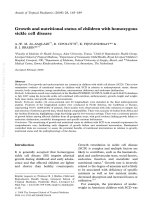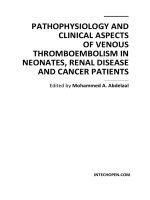BEER: QUALITY, SAFETY AND NUTRITIONAL ASPECTS potx
Bạn đang xem bản rút gọn của tài liệu. Xem và tải ngay bản đầy đủ của tài liệu tại đây (9.28 MB, 156 trang )
BEER: QUALITY, SAFETY
AND
NUTRITIONAL ASPECTS
RSC
Paperbacks
RSC Paperbacks are a series of inexpensive texts suitable for teachers and students and
give a clear, readable introduction
to
selected topics in chemistry. They should also
appeal to the general chemist.
For
further information
on
all available titles contact:
Sales and Customer Care Department, Royal Society
of
Chemistry,
Thomas Graham House, Science Park, Milton Road, Cambridge CB4
OWF,
UK
Telephone: +44 (0)1223 432360; Fax:
+
44 (0)1223 423429; E-mail:
Recent Titles Available
The Chemistry
of
Fragrances
compiled by David Pybus and Charles Sell
Polymers and the Environment
by Gerald Scott
Brewing
by Ian
S.
Hornsey
The Chemistry
of
Fireworks
by Michael
S.
Russell
Water (Second Edition):
A
Matrix
of
Life
by Felix Franks
The Science
of
Chocolate
by Stephen
T.
Beckett
The Science
of
Sugar Confectionery
by
W.
P. Edwards
Colour Chemistry
by R. M. Christie
Beer: Quality, Safety and Nutritional Aspects
by
E.
Denise Baxter and Paul
S.
Hughes
Future titles may be obtained immediately on publication
by
placing a standing order
for RSC Paperbacks. Information on this is available from the address above.
RSC
Paperbacks
BEER: QUALITY, SAFETY
AND
NUTRITIONAL ASPECTS
E.
DENISE
BAXTER
Brewing Research International,
Lyttel Hall, Nutjield, Redhill, Surrey RHl
4H
Y,
UK
PAUL
S.
HUGHES
Heineken Technical Services,
Burgemeester Smeetsweg 1,
2382
PH Zoeterwoude,
The Netherlands
RSmC
ROYAL
SOCIETY
OF
CHEMISTRY
ISBN 0-8 5404-58 8-0
A
catalogue record for this book is available from the British Library
0
The Royal Society of Chemistry 2001
All rights reserved.
Apart from any fair dealing
for
the purpose
of
research
or
private study,
or
criticism
or
review as permitted under the terms
of
the
UK
Copyright, Designs and
Patents Act,
1988,
this publication may not be reproduced, stored
or
transmitted,
in any form
or
by any means, without the prior permission in writing
of
The Royal
Society
of
Chemistry,
or
in the case
of
reprographic reproduction only in
accordance with the terms
of
the licenses issued by the Copyright Licensing
Agency in the
UK, or
in accordance with the terms
of
the licences issued by the
appropriate Reproduction Rights Organization outside the
UK.
Enquiries concerning
reproduction outside the terms stated here should be sent to The Royal
Society
of
Chemistry at the address printed on this page.
Published by The Royal Society
of
Chemistry,
Thomas Graham House, Science Park, Milton Road,
Cambridge CB4
OWF,
UK
Registered Charity Number 207890
For further information see our web site at www.rsc.org
Typeset
in
Great Britain by Vision Typesetting, Manchester
Printed by Bookcraft Ltd,
UK
Preface
Beer has been a popular beverage for thousands of years and brewing is
often described as the oldest biotechnological process. Over the years the
brewmaster’s art has been supplemented by vast increases in our knowl-
edge of the chemistry and biochemistry both of the ingredients and of the
changes taking place to those ingredients during brewing. Together these
contribute to give the products we recognise today
-
a
wide range
of
different but consistently high quality beer types.
This book aims to explain the scientific principles which underpin
those aspects of beer which are of the great interest to the beer drinker
-
namely its taste, appearance and nutritional qualities. This book
is
very
much a synthesis of the current thinking as many aspects of beer quality
are still tantalisingly elusive,
so
the story cannot be completed at the
moment.
. . .
v
Glossary
xi
Chapter
1
An
Overview
of
the Malting and Brewing Processes
Malting
Mashing
Wort Boiling
Wort Clarification
Fermentation
Maturation
Packaging
Summary
Further Reading
Chapter 2
Beer Quality and the Importance
of
Visual Cues
Introduction
Physical Properties
of
Beer Foam
What is Beer
Foam?
Nucleation
Foam Ageing
Beer Foam Components
Pro teins/Polypeptides
Pol
y
saccharides
Hop Bitter Acids
Metal Cations
Alcohols and Lipids
Gas Composition
PH
Other Components
Foam Parameters
1
1
4
8
9
9
11
12
13
13
14
14
14
14
15
17
18
18
19
19
20
21
21
22
22
23
vii
Vlll
Contents
Foamability
Foam Stability
Foam Drainage
Cling
Viscoelas t ici t
y
Lateral Diffusion
Film Thickness
Bubble Size
Foam Structure
Improving Foam Stability
Propylene Glycol Alginate
(PGA)
Chemically-modified Iso-a-acids
Choice
of
Raw Materials
Dispense Hardware and Gases
Foam Assessment
The Effects of Process on Final Foam Stability
Beer Colour
Perception
of
Colour
Light-absorbing Species
in
Beer
Beer Colour Measurement
Beer Clarity
Summary
References
Chapter
3
Flavour Determinants
of
Beer Quality
Introduction
The Taste
of
Beer
Sweetness
Sourness
Saltiness
Bitterness
Beer Aroma
Esters
Alcohols
Vicinal Diketones
Sulfur Compounds
Hop Aroma
Malt Flavours
Other Contributors to Beer Flavour
Drinkability
23
23
24
24
24
25
25
25
25
27
27
28
28
29
29
30
31
31
32
33
36
37
38
40
40
41
41
42
43
43
48
48
48
51
52
58
64
66
66
Contents
ix
The Mouthfeel of Beer
Sensory Assessment of Beer
Beer Flavour
Summary
References
Understanding Sensory Data
Chapter
4
Maintenance
of
Beer Quality
Introduction
Beer Flavour Stability
Potential Sources of Flavour Instability
Distortion of Beer Flavour
Solving Flavour Instability
of
Beer
Foam Stability
The Formation
of
Haze
Pol yphenol-Polypeptide Hazes
Calcium Oxalate
Carbohydrates
Other Sources of Haze in Beer
Brewery Spoilage Organisms
Microbiological Contamination and Beer Quality
Summary
References
Chapter
5
Nutritional Aspects
of
Beer
Beer Components
of
Nutritional Value
Water
Alcohol
Carbohydrates
Proteins, Peptides and Amino Acids
Lipids
Fibre
Energy Value
Minerals
Vitamins and Micronu trien ts
Phenolic Compounds
Hop
Bitter Acids
Metabolism
of
Alcohol
Risks and Benefits of Drinking Alcohol
68
68
70
71
72
73
74
74
74
75
86
88
88
90
90
92
93
93
93
94
96
96
98
98
99
100
102
103
104
104
104
105
107
109
112
113
115
X
Contents
Potential for Future Development
Summary
References
Chapter
6
Assuring the
Safety
of
Beer
Risks
to Food Safety
HACCP
Raw Materials
Processing
Microbiological Safety
Packaging
Deliberate Tampering
Allergens
Summary
Further Reading
Subject Index
117
118
118
120
120
121
125
131
131
132
133
133
134
135
136
Glossary
a-Acids:
The major constituent of the resin (humulones) in hop cones:
a-acids are converted to bittering substances (iso-a-acids) during wort
boiling.
Adjunct:
Any source
of
fermentable extract other than malted barley used
in the mash tun or the copper. May be solid,
e.g.
cereal grits, or liquid
e.g.
sugar syrup.
Air rest:
An interruption of the steeping process to allow the barley to
absorb oxygen from the air and thus to overcome water sensitivity and to
ensure even germination.
Ale:
Originally an unhopped but fermented malt drink, the term ale
nowadays refers to any beer produced at temperatures
of
between
16
and
21
"C
(most frequently around
18
"C)
using a top-fermenting yeast
(Saccharomyces cerevisiae).
Aleurone:
The thick layer of living cells which surrounds the starchy
endosperm in mature barley kernels.
Amylopectin:
The second major constituent of barley starch, amylopectin
is a large, highly branched molecule consisting
of
glucose units linked by
a-1,4
and
a-1,6
bonds.
Amylose:
One of the two main components of barley starch. Amylose
consists of a linear chain of glucose molecules linked by
a-1,4
bonds.
Attentuation:
The reduction in density of wort which occurs during
fermentation as sugars are converted to alcohol.
Beer:
In the
UK,
the legal definition of beer is for Excise purposes, and
defines beer
as
any liquor made or sold as beer. The clearest technical
definition describes beer as a fermented liquor produced mainly from
malted barley but including other carbohydrate sources and flavoured
with hops.
Cask:
A
large container for draught beer, originally made of wood, but
now may also be made of aluminium. Traditionally, beer casks came in
seven sizes: butt
(108
gallons), puncheon
(72
gallons), hogshead
(54
gal-
lons), barrel
(36
gallons), kilderkin
(18
gallons), firkin
(9
gallons) and pin
(4.5
gallons).
NB
1
gallon
=
4.54
litres.
xi
xii
G
1
ossary
Cold break:
The precipitate formed when wort is cooled to room tempera-
tures, consisting mainly of protein.
Copper:
The vessel in which wort is boiled with hops to obtain the
characteristic bitter flavours. So-called because it traditionally was made
of copper, now often made
of
stainless steel. Also known as the kettle.
Crystal malt:
Malt whose endosperm has been converted to a sugary
crystalline mass during kilning. A proportion of crystal malt is added to
the grist to provide colour and flavour to certain beers, particularly
British ales.
Cylindroconical vessel:
A cylindrical vertical tank with a conical base in
which the yeast sediments after fermentation. Temperature is controlled
by cooling-coils around the walls. Capacity ranges from
200
to
6000
hectoli tres.
Embryo:
The part of the barley kernel which gives rise to the new plant.
Endosperm:
The part of the barley kernel other than the embryo. The
endosperm consists essentially of
a
store of food for the new barley plant.
Finings:
Charged colloidal substances, prepared from isinglass (collagen)
from the swim bladders of certain tropical fish.
Flocculation:
The clumping together of yeast cells at the end of fermenta-
tion. Also used to describe the clumping together of protein precipitated
during wort boiling.
Germination:
The sprouting of the resting barley seed to form new roots
and shoots. The first visible sign is the cream-coloured ‘chit’ or first root
emerging from the embryo end of the barley kernel.
Gibberellins:
Natural plant hormones (phytohormones) produced by the
barley embryo in response to steeping in water. Gibberellins stimulate the
production of enzymes in the endosperm which hydrolyse the stored food
reserves in the embryo and make them available to the growing plant.
Green beer:
Freshly produced beer immediately after the end
of
primary
fermentation and before conditioning (maturation).
Green malt:
Barley germinated for between one and five days, before
kilning, with a moisture content of at least
40%.
Grist:
The term given to the mixture of coarsely ground malted barley,
together with milled raw cereals and speciality malts (and barley) such as
crystal malt or roast barley. Includes liquid adjuncts such as syrups. May
also be applied to the mixture of hops and hop pellets added to the copper.
Hops:
A perennial climbing vine,
Humulus
lupulus,
a member of the family
of
Cannabinaceae.
First recorded use to flavour beer was in Egypt,
600
years BC. The part traditionally used in brewing is the hop cone, which is
the female ripened flower. In modern brewing, the hop cones are either
extracted or finely powdered and compressed to form hop pellets which
keep better and are easier to transport.
Glossary
Xlll
Hordein:
The main component of barley protein. Closely related to
similar proteins in wheat (gliadins), rye (secalins) and maize (zeins).
Hot break:
Term given to the precipitate of protein which forms in boiled
wort when it is cooled. Also called trub.
Husk:
The outer, protective layers of the barley kernel, formed from the
fruit and seed coats.
Isinglass:
Collagen from the swim bladders of certain tropical fish, used as
finings
(qu)
in beer to assist clarification.
Kettle:
Another term, originally American, for the vessel in which wort is
boiled. See also ‘copper’.
Kilning:
The final stage
of
malting in which the green malt is dried and
cured by heating in a draught of warm air. The final temperature depends
upon the type
of
malt being made.
Lager:
A
pale straw coloured beer produced from a lightly kilned malt
and fermented by bottom-fermenting yeast
(Saccharornyces
carlsbergen-
sis)
at a low temperature
(7-13
“C) and matured for several weeks.
Lautering:
The process by which the sweet wort
is
separated from the
spent grains, by drawing it
off
through the bed of spent grains.
Lauter tun:
Vessel in which wort is separated from the spent grains by
filtration through the spent grain bed. Generally
a
wide shallow vessel
fitted with rakes to break up the bed.
Mashing:
Process in which milled malt is mixed with hot water to extract
cereal components, mainly starch. This starch is then converted to fer-
mentable sugars by enzyme action.
Mash
tun:
The vessel in which mashing occurs. May also be called the
‘conversion’ vessel. In traditional ale brewing, the wort is also separated
from the spent grains in the mash tun. However, in modern practice, it is
more common to transfer the mash to a specific filtration vessel, the
lauter tun
(qu).
Original gravity
(OG):
This is the gravity
of
the wort prior to fermenta-
tion. In general, the higher the gravity, the more alcohol is produced, but
there is no absolute correlation since worts may contain varying propor-
tions of unfermentable material (such as protein). In addition, some types
of
beers retain some sugars that are potentially fermentable. The
OG
has
often been the basis for calculating the excise duty payable, but nowadays
the final alcohol content is more generally used.
Paraflow:
A plate heat exchanger for cooling wort after boiling. Also used
to cool beer before packaging.
Primings:
Sugar added after the primary fermenatation, particularly to
traditional mild ales and sweet stouts, to add some sweetness. May also
be added to cask ales to provide additional fermentable extract for
secondary fermentation in the cask.
xiv
Glossary
Racking:
The process of filling beer into casks, kegs or storage tanks after
ferment a ti on.
Small beer:
A light, digestible table beer, relatively low in alcohol
(OG
<
1025")
produced from the Middle Ages by re-extracting grist
already partially extracted to produce a strong ale.
Sorghum:
A small-grained cereal grown in Africa and southern USA
which can be used for brewing beer.
Spent grains:
The residue of milled malt left after mashing. Spent grains
consist mainly of husk and bran layers. They are relatively rich in protein
and are used as cattle feed.
Steeping:
The first stage of the malting process. Involves soaking the
barley grain in water until the moisture is raised from
12%
to
45%.
Generally involves two or more immersion stages separated by air rests
Stillage:
A
wooden or metal structure which supports beer casks in a
horizontal position in the cellar prior to dispense, allowing the yeast and
protein to sediment with the finings and clarify the beer.
Trub:
The coagulated protein which separates out in the wort after
boiling. Also known as the 'hot break', the word trub is derived from a
German word meaning 'break'.
Tun:
A term used to describe any large vessel in
a
brewery,
e.g.
mash tun,
lauter tun
etc.
Whirlpool:
A
type of centrifuge used to separate the hot break or trub
from the wort on cooling.
Wort:
The sweet syrupy liquid which results from extraction and hydroly-
sis
of starch from malted barley during mashing. After the addition of
hops during boiling, sweet wort becomes bitter wort.
Yeast:
A single-celled microorganism which, in the absence of oxygen,
can use glucose as a respiratory substrate and convert it
to
ethanol. The
two main strains used in brewing are
Saccharomyces carlsbergensis
(bot-
tom fermenting lager yeast) and top fermenting ale yeast
Saccharomyces
cereuisiae.
Individual brewing companies each have their own sub-strain,
selected over countless generations for particular properties regarded as
desirable to the brewer.
(P).
Chapter
1
An
Overview
of
the Malting and
Brewing Processes
MALTING
The story of beer starts with ripe barley grain, plump and sound, with a
moderate (for a cereal) protein content of 10-12%. The barley kernel is
roughly ovoid in shape, surrounded by protective layers of husk, with
a
small embryo at one end. This embryo is the part that will grow into the
new plant, given the chance. The remaining part of the kernel is the
endosperm, which is basically just a store of food for the young plant.
Most of the endosperm consists of large dead cells with thick cell walls
consisting mainly of P-glucan (a polymer of glucose molecules linked by
P-glycosidic bonds) together with some pentosan (an arabinoxylan poly-
mer) and a little protein.
These cells are stuffed with starch granules, which come in two sizes;
large (about
15-20
pm diameter) and small (about 2 pm diameter). There
are very many more small granules than large granules but they account
for less than
5%
of the weight of the starch. These starch granules are
embedded in a matrix of hordein. This is an insoluble protein which
provides a store
of
peptides and amino acids for the new plant. The whole
of the starchy endosperm is surrounded by the aleurone, which is a triple
layer
of
living cells.
The whole aim of the malting process is to get rid of as much as possible
of
the the P-glucan cell walls and some of the insoluble protein which
would otherwise restrict access of enzymes to the starch granules. At the
same time enzymes are developed which will, in the brewhouse, convert
the starch into soluble sugars.
In the maltings the barley is steeped to raise the water content from
12% to around
45%.
This process takes about
48
hours and consists of
two or three periods when the grain is totally immersed in water, inter-
2
Chapter
1
embryo
scutellum
aleurone
husk
\
distal end
awn
A/
starchy endosperm
Figure
1.1
Diagrammatic view (longitudinal section)
of
a barley grain
spersed with 'air rests' when the water is drained off and fresh humidified
air is blown through the grain bed to provide oxygen. The increased
water content stimulates respiration in the embryo and hydrates the
stores
of
starch in the endosperm. As the embryo activity increases,
gibberellins are produced. These are natural plant hormones that diffuse
into the aleurone, where they stimulate the production
of
hydrolytic
enzymes during germination.
The moist grain is then allowed to germinate for a few days. During this
time cool humidified air is again blown through the grain bed to keep the
temperature down to around 16
"C
and to stop the grain drying out. As
gibberellins diffuse into the endosperm from the embryo they stimulate
the aleurone cells to produce hydrolytic enzymes. These include
amylolytic enzymes, which break down starch, proteolytic enzymes,
which attack the protein, and cellulytic enzymes, which break down cell
walls. Proteolytic enzymes include carboxypeptidases, which release one
amino acid at a time starting from the carboxyl end of an amino acid
chain, and endopeptidases, which can break peptide bonds in the centre
of
long amino acid chains. They can therefore very rapidly reduce the size
of
a
protein or polypeptide. Next P-glucanases are produced. These break
down the endosperm cell walls, making it easier for the other enzymes
to
diffuse out into the starchy endosperm. Last, but not by any means least,
amylolytic enzymes are produced. The two most important are u-amylase
and P-amylase, both of which can break down a-1,4 bonds.
A
debranch-
ing enzyme, which can attack the 1,6 bonds, is also produced, but this
enzyme is quite sensitive to heat and
so
is normally inactivated during
malt kilning.
All of these enzymes must diffuse into the starchy endosperm and begin
the process
of
breaking down the cellular structure (the cell walls) and the
An Overview
of
the Malting and Brewing Processes
3
Barley
f
Steeped barley
Germination
circa
16
'C,
3-4
days
f
Green malt
Kilning
45
"C
rising to
85
"C,
24
hours
(lager malt)
or
90-100
"C (ale malt)
Ale
and Lager
Malt
-
Figure
1.2
Simplifiedflow diagram
of
the malting process
stores of protein, starch and lipid in order to provide nutrients for the new
plant. This process is strictly controlled by the maltster, who curtails it
after four or five days. By this time most of the cell walls should have been
digested, since if these are allowed to remain they will cause processing
difficulties at
a
later stage. Part of the high molecular weight, insoluble
protein will also have been broken down into smaller fragments (peptides
and amino acids) and sufficient amylolytic enzymes will have been syn-
thesised. Most of the starch remains intact, except for the small granules,
which are the first to be digested during malting. If these small granules
persist in the malt they can cause filtration problems for the brewer
during the later stages of beer production.
4
Chapter
1
The damp ‘green’ malt is dried in a kiln to prevent further enzyme
activity and to produce a stable material which can be safely stored until
needed for brewing. The kilning process also removes the volatile compo-
nents responsible for undesirable ‘grainy’ flavours, and encourages the
development of more attractive malty, biscuity flavours. This flavour
development depends very much upon temperature and thus can be
controlled by the maltster in order to produce a wide range of malts. The
majority of commercial malts are fairly lightly kilned (up
to
85OC) in
order to produce lager malts. In the
UK
a substantial proportion is
kilned to a higher temperature (usually
90-100
“C) to give somewhat
darker and more flavoursome pale ale malts. Higher temperatures (up to
200
“C)
are used to produce speciality malts with flavours ranging from
the toffee, caramel flavours of crystal malts to the sharp astringent
flavours of roasted malts. These different malts can then be used by the
brewer to produce beers with a wide range of flavours and colours (see
Chapter
3).
MASHING
The brewing process converts the malt starch first to soluble sugars, then
uses yeast to ferment these to alcohol. At the same time proteins are
broken down into amino acids which can be used by the yeast as
nutrients, coincidentally producing characteristic flavour compounds.
In the brewhouse the malt is crushed in a mill. Often a roller mill will be
used
-
this keeps the husk largely intact
so
that it can serve as an aid to
filtration later in processing. The crushed malt (‘grist’) is mixed with hot
water in the mash tun and the whole mash is held at around
65°C
for
about one hour. This temperature is chosen as it is the temperature at
which malt
(i.e.
barley) starch will gelatinise
-
making it more susceptible
to enzyme attack.
Sometimes other cereals (‘adjuncts’) may form part of the grist, in order
to provide specific qualities in the beer. For example, small quantities of
wheat are often used in ales to enhance the beer foam, while unmalted rice
and maize grits may be used to improve the flavour stability of light-
flavoured lagers. The more intensely kilned malts (crystal, amber, or
brown malts) are used to provide colour and flavour in traditional British
ales, while roasted malt and barley are used in the darker porters and
stouts (see Chapter
3).
Like barley starch, wheat starch also gelatinises at
65°C.
Rice and
maize starches gelatinise at higher temperatures,
so
if either
of
these
cereals is used as an adjunct, it must be pre-cooked in a separate vessel
(known as a cereal cooker) before being added to the mash.
An
Overview
of
the Malting and Brewing
Processes
Grist
+
Ale or lager malt
(90-100%)
speciality malts
(0-1
0%)
\
5
Water
Mash
Lautering
(wort separation)
I
Sweet Wort
+
Spent grains
f
Bitter Wort
Yeast
Fermen ta tion
4
Green beer
Ma tura tion
f
Filtration
Beer
-
Figure
1.3
Simplijedjow diagram
of
the
brewing process
6
Chapter
1
In some mashing systems, particularly those used for lagers, where the
malts may have been less completely modified during malting, the mash
may initially be held at a lower temperature (around
45
"C) to allow the
breakdown of cell walls and protein which commenced in malting to
continue. After about
30
minutes the temperature is then raised to
70 "C.
At this temperature the starch will gelatinise and it can then be broken
down by the amylase enzymes in the mash.
During mashing the amylolytic enzymes in the malt break down the
starch into fermentable sugars. Cereal starch consists of approximately
75%
amylopectin and
25%
amylose. Amylopectin is a very large, bran-
ched molecule (the molecular weight has been estimated at several mil-
lion) made up of glucose units linked by
a-1,4
bonds (which give linear
chains) and
a-1,6
bonds (which give branch points). On average, each
branch is made up of around
25
glucose units. Amylose, on the other
hand, is
a
linear molecule made up of up to
2000
glucose units linked by
a-
1,4
bonds only (Figure
1.4).
Both a-amylase and P-amylase can hydrolyse
a-1,4
bonds. P-Amylase
attacks from the outer reducing ends of the amylopectin and amylose
molecules, releasing free maltose (two glucose units), but stopping when it
reaches an
a-1,6
bond. In contrast, a-amylase attacks lengths of
a-1,4
chains between branch points, releasing smaller, branched dextrins with
long straight side-chains. These provide more substrates for P-amylase
action.
a-
and P-Amylase acting together reduce amylose to maltose,
maltotriose and glucose, but amylopectin gives rise, in addition,
to
many
small branched dextrins which cannot be further broken down during
mashing.
Thus after the conversion stage (mashing) a sweet syrupy liquid known
as 'wort' is produced. This liquid contains mainly maltose and glucose,
which are fermentable, together with significant quantities of small bran-
ched dextrins, which are not fermentable. There may be traces of larger
straight-chain dextrins, the amount of which depends upon the enzymatic
activity of the malt and the mashing conditions, and thus can to some
extent be manipulated by the brewer.
No
starch should survive the
mashing stage. The wort will also contain soluble protein, polypeptides
and amino acids.
In traditional British ale mashing, the wort is separated from the spent
grist in the mash tun by being allowed to filter through the spent grain
bed into the next vessel. Hot water (usually at least
70
"C)
is sprayed onto
the top of the grain bed in order to extract and wash out the soluble
components. This is known as sparging. A more usual practice nowadays
is for the whole mash to be transferred to
a
separate vessel, the lauter tun.
This vessel has a perforated base plate which allows the wort to run
An Overview
of
the
Malting and Brewing Processes
\
\
CH20H CH20H
7
amylopectin
a
-1,4
and
-1,6
Non-reducing end
Amylose
Non-
reducing end
I
Key
=
glucoseunit
1
Figure
1.4
Structure
of
arnylose
and
amylopectin
through into the next vessel, the kettle
or
copper, leaving the insoluble
remains
of
the malt, (the spent grains) behind in the lauter tun.
WORT
BOILING
In the kettle, hops or hop extracts are added and the wort is boiled quite
vigorously. This has three effects:
8
Chapter
1
OH
?2+R
HO
0
Y
a
-acids
0
"" t +*H
co
I
A
iso- a-acids
Acyl side chain
(R)
-
COCH2CH(CH3)2
=
Humulone
-
COCH(CH3)2
=
Cohumulone
-COCH(CH3)CH2CH3
=
Adhumulone
Figure
1.5
Structure
of
hop
acids
The wort is sterilised.
Much of the soluble protein is coagulated and can be separated
off
as
the 'trub'.
The a-acids in the hops are extracted into the wort and isomerised into
iso-a-acids, which provide the characteristic bitter taste of beer (see
Figure
1.5).
In addition to a-acids, hops contain essential oils, which contribute to the
hoppy, floral and spicy aromas in beer (see Chapter
3).
Most of these
compounds are volatile and can therefore be lost by evaporation during
boiling. In order to effect a suitable compromise between sufficient
boiling to coagulate protein and isomerise the hop acids, but still retain
the desired quantity of aroma compounds, the brewer may add part of the
hop recipe part-way through the boil.
Also during boiling, browning reactions take place between the reduc-
ing sugars and the primary amines (particularly amino acids) in the wort,
resulting in an increase in wort colour and some loss of free amino
nitrogen. Browning reactions are complex and still not completely char-
acterised, but basically consist
of
condensation reactions between simple
sugars, such as glucose, with primary amines (for example the amino acid
glycine) to give aldosylamines. These are relatively unstable compounds
and can undergo Amadori rearrangement to form ketosamines, which
An
Overview
of
the Malting and Brewing Processes
9
condense with another aldose molecule to form diketosamines. Reacting
in the enol form, these diketosamines can undergo further condensation
reactions with additional amines to form a mixture of reddish-brown
pigments, most of which contain a furfural ring.
A
simplified reaction
pathway is shown in Figure 1.6. To some extent the amino acids act as
catalysts, and the increase in colour is much greater than the loss of
amino acids.
WORT
CLARIFICATION
After boiling, the coagulated protein or 'trub', together with the spent
hops, must be removed. Traditionally this was achieved by filtering the
wort through the bed of spent hop cones. In modern breweries most of the
hops are in the form of pellets or extracts, with much less waste leafy
material to form a filter bed, and
a
vessel known as a whirlpool is used
instead. The hot bitter wort is pumped into the whirlpool tangentially.
The resulting swirling motion causes the trub to collect at the centre
of
the vessel as a conical mound. The clear wort can be removed from an exit
pipe, which
is
situated to the side
of
the vessel. The bitter wort is then
cooled to fermentation temperature by passing it through a paraflow heat
exchanger.
FERMENTATION
Fermentation takes place at 7-13
"C
for lagers or 16-18 "C for ales. Yeast
is mixed with the cooled wort and the mixture pumped into the ferment-
ing vessel. During fermentation the yeast takes up amino acids and sugars
from the wort. The sugars are metabolised, with carbon dioxide and ethyl
alcohol being produced under the anaerobic conditions found in brewery
fermentations (Figure 1.7):
The amino acids are used for cell growth,
so
that at the end of fermenta-
tion the yeast will typically have increased its mass by up to 10-fold. The
yeast also produces a number of flavour-active volatile compounds,
mainly higher alcohols and esters, the exact profile of which will vary
from strain to strain. (More details of the contribution of yeast to beer
flavour are given in Chapter
3.)
Thus the yeast is responsible for much
of
the unique character which distinguishes one beer from another. Most
brewers have their own strain or strains, which may have been in use since
the brewery was founded, decades or even centuries ago.









